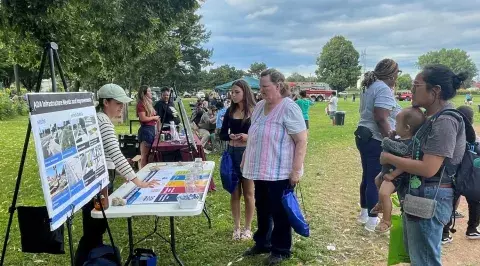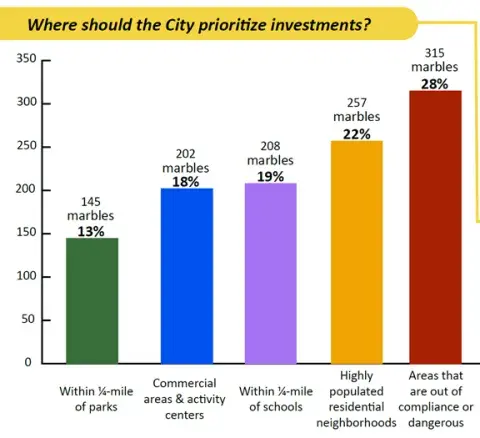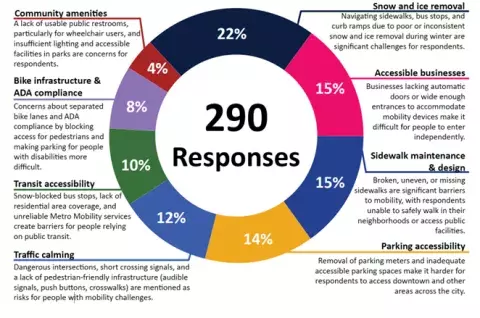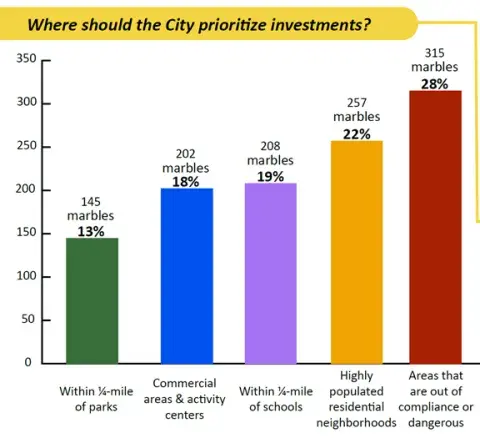How this feedback will be used:
The project team is incorporating community input received in Phase 1 outreach to inform the priorities outlined in the ADA Transition Plan. Current policies will be reviewed and the ADA Transition Plan will suggest improvements to meet ADA needs.
We will be having more community engagement opportunities in 2025 to inform the community of our findings.
AMERICANS WITH DISABILITIES ACT (ADA) TRANSITION PLAN
Phase I Engagement Summary
Our engagement efforts
Phase I of Engagement for the Public Works ADA Transition Plan occurred between June and October of 2024. During this phase, two strategies were used to introduce the project to the community: gather input on current issues and needs, and understand how accessibility and the infrastructure system is working for the community. This document summarizes the engagement and feedback received throughout Phase I.
Events and participants
- 5 community events and pop ups
- Safe Summer Nights, West Minnehaha Recreation Center
- Rice and Larpenteur Summer Block Party
- West Side Farmers Market
- Marydale Festival
- Open House at the Rondo Community Library
- 290 online survey responses
- 7 presentations to District Councils and City Committees
- Mayors Advisory Committee for People with Disabilities (MACPD)
- City of Saint Paul Transportation Committee
- North End Neighborhood Organization
- CapitolRiver Council
- Highland District Council Transportation Committee
- The ARC
- City of Saint Paul Advisory Council on Aging (ACOA)
- 26 public open house participants
- 43 community focus group participants
Results of engagement
To understand where accessibility investments ranked for community members, participants at in-person engagement events were asked to prioritize accessibility investments. Using marbles, each participant was asked to “spend” marbles in areas they would prioritize for ADA improvements. Priority area options included prioritizing investments:
- Within a quarter mile of parks
- Commercial areas & activity centers
- Within a quarter mile of schools
- Highly populated residential neighborhoods
- Areas that are out of compliance or dangerous
What we heard from the public
- Winter maintenance like snow clearing is critical for sidewalk accessibility.
- Navigating construction that impacts the street or sidewalks is very difficult due to obstructions.
- Most residents shared experiences with cars not stopping or yielding for people in crosswalks.
- Parked scooters and shared bikes are a significant issue when navigating the sidewalk.
- Widespread support for system-wide improvements for people with disabilities.
- Uneven or broken sidewalks prevent residents using mobility devices from being able to move freely.
- Consider the needs of multiple types of disabilities when evaluating accessibility.
- The ADA Transition Plan should consider best practices, not just legal compliance.
Online survey results
An online survey was shared to collect feedback from residents in the community. Surveys were distributed via direct outreach at in-person engagement events and shared online through GovDelivery email outreach, and shared on agency and partners social media channels. The survey focused on understanding people’s experiences navigating the city, perceptions about the quality of the public realm and amenities offered, and aspirations for future accessibility improvements.
How this feedback will be used
The project team is incorporating community input received in Phase I outreach to inform the priorities outlined in the ADA Transition Plan.




